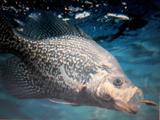
Slabsrus has great advice. Start with a contour map. If one doesn't exist make one. Your looking for key areas that typically hold Crappie. Like most creatures Crappie are creatures of habit. They do the same thing from one year to the next.
Start with the obvious locations at your lake. Points/fingers on land are the same under water, they extend into the water. IF you have two fingers with a channel between them, fish it every time you go out. The channel will be deeper than the fingers. Generally what the finger looks like on land is the same it looks like under the water. Look for submerged trees and fish those. Most of the time you will see the root ball next to shore, the crown of the tree will entend into the water, and Crappie will be under it. Fishing trees from the lake can be challenging, fish it from shore has other challenges, but it can be done.
When I fish wood I use a light hook, #6 and heavier line, say 10 pound mono, or you could use one of those braided lines. The reason for that set up is to save some tackle. When you get hung up, and you will get hung up, try snapping the line, steady pull from one side or the other, if your still hung up. A strong steady pull, with your hand on the line, not the reel, pull to straighten the hook. You can bend it back into shape with a pair of needle nose pliers, same ones you use to unhook fish hooked deep.
To find what hte bottom "looks like". Tie on a lead weigth, no hook, and cast if out there. Let is sink to bottom. If your bobber stands up, you need to go deeper, if the bobber lays flat your on bottom. Slide the slip not up or down until you knwo how deep it is. Tie on your hook, and slide the bobber stop a couple of feet towards the hook. This moves the hook off the bottom a couple of feet. Crappie feed up, in other words they look up to eat. IF your bait is eye level, they will hold it in there mouth and you may never know. Some call it a light bite. When that happens to me, I raise the bait higher. I want them to come up, grab the bait and take if back to where they were. This pulls the bobber down and I set the hook. Speaking of hook set, swing the rod to the side to set the hook. Dont pull up over your head, swing it over your shoulder, or better yet under your arm pit. Watch your neighbor.
I higly recommend you find a local Crappie fisherman you can tag along with on a trip or two. Keep reading the threads. I'd write more, however the wfie is due back any minute and it'll be time to eat.
HOI Crappie Club
Where family and friends come to compete for a little more than bragging rights.
Quick, someone teach me how to fish so I can win this tournament!!!


 Likes:
Likes:  Thanks:
Thanks:  HaHa:
HaHa: 

 Reply With Quote
Reply With Quote Lets go soak a line. Pat
Lets go soak a line. Pat
















